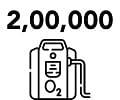Your Contribution Will Go A Long Way

Oxygen concentrators needed across India currently

Average cost of an oxygen concentrator ($600)

Patients that can be treated by one oxygen concentrator

Oxygen concentrators needed across India currently

Average cost of an oxygen concentrator ($600)

Patients that can be treated by one oxygen concentrator
Why this cause?
India is currently experiencing its biggest surge in COVID cases since the pandemic began, and this devastating second wave has completely overwhelmed the country’s health infrastructure. At present, amongst the biggest challenges is a severe shortage of oxygen. After much consideration, we determined that our impact would be greatest if we help aid towards supplying oxygen through the purchase of oxygen concentrators.
Why Oxygen Concentrator?
Oxygen concentrators are medical devices that concentrate oxygen from ambient air - providing a sustainable source of oxygen supply that is not dependent on manufacturing or supply chain constraints. As oxygen concentrators last for many years, this is also not just a short-term solution, but importantly, a long term one that strengthens the broader health system. “Low flow” concentrators cost USD 600 and can treat and save the lives of up to 900 patients with mild to moderate illness. “High flow” concentrators cost USD 1100 and can treat and save the lives of up to 550 patients with a severe or critical illness..
What is Meltwater doing?
We are raising funds through crowd-funding. Meltwater is partnering with Milaap to crowdfund and support health non profits Swasth and ACT Grants to procure and deploy oxygen concentrators and other medical supplies to aid the fight against COVID crisis in India.
Who are our partners?
The funds that we raise will be donated to Swasth and ACT grants.
Swasth is a not-for-profit alliance of healthcare providers, working with public and private health systems to coordinate their resources and response to COVID-19. Swasth.app
ACT is a social change movement for the start-up ecosystem in India, enabling changemakers to give their time, talent and resources to mobilize solutions that address societal problems at scale. actgrants.in
Swasth along with ACT Grants is procuring oxygen concentrators and distributing these to hospitals across the country that’ll save numerous lives as well as strengthen the health system in the longer term. They can also be used to treat outpatients, reducing the load on hospital occupancy.
Learn more about the impact here here.